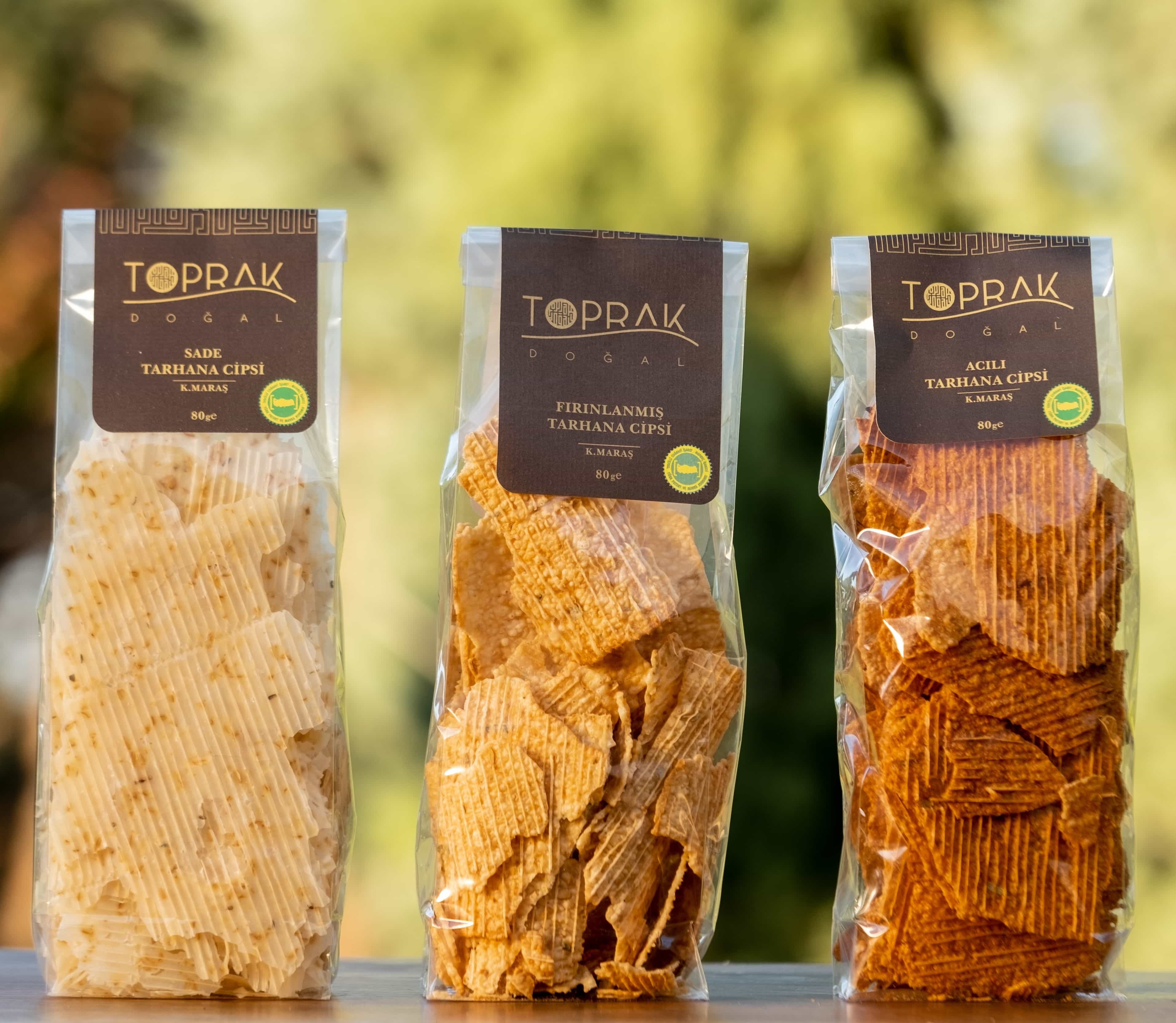
Ready Flavor Tarhana From Soup to Chıps!
When you think of soup, tarhana is the first that comes to mind. Questions like "Does tarhana soup cause gas?", "Can babies have tarhana soup?", "snack tarhana", "tarhana chips", "winter tarhana", "Uşak Tarhanası", and "Maraş tarhanası" are some of the most searched topics online. In this article, we answer all your questions about tarhana.
Throughout its ten-year successful brand journey, Toprak Doğal, guided by the principles of its meticulous manager Hümeyra Arslan, sources “the best” and “the most natural.” Toprak Doğal does not use artificial additives, preservatives, or colorants in its products. The foods offered to consumers are produced entirely through natural processes and according to regional recipes, ensuring that the products are both purer and more natural.
Every Region Has Its Own Tarhana
While every region has its own version of tarhana, two geographically indicated types are particularly famous in Turkey: Uşak Tarhanası and Maraş Tarhanası. We have compiled everything you need to know about tarhana, one of the stars of Turkish culinary culture, including its varieties, how it is made, and delicious recipes you can try with tarhana.
Unique to Turkish Cuisine but With Similar Versions!
Research shows that Turkish cuisine is considered one of the world's top three cuisines, along with Chinese and French cuisines. This isn't surprising, as the culinary traditions of a region are deeply rooted in the processing of local products and the customs, traditions, and practices associated with them. Naturally, the rich Turkish culture has created a rich Turkish cuisine.
Tarhana, a staple of Turkish cuisine, falls under the category of dried soups. It is prepared in advance, has a long shelf life, and is cooked by adding water when needed. The idea of a ready-to-eat soup that can be prepared as easily as tarhana during the winter months is so appealing that similar products have been made in other countries. Examples include kishk in Egypt, Syria, Lebanon, and Jordan; kushuk in Iraq; trahana in Greece; and tahonya/talkuna in Hungary and Finland.
The History of Tarhana, the Ancestor of Ready Soups
If there is an ancestor of ready soups that can be stored for a long time without spoiling and is quick and easy to cook, it is tarhana soup. Although there is no definitive information about where and how it was first made, it is believed that tarhana was introduced to the Middle East, Anatolia, Hungary, and Finland by Turks and Mongols who migrated from Central Asia.
In the Turkish-Arabic dictionary "Divanü Lûgât’it Türk", written by Kâşgarlı Mahmud in Baghdad between 1072-1074, the word "Tar" is used for tarhana, meaning "yogurt prepared for winter from summer". We understand from this that the name tarhana comes from one of its main ingredients, yogurt.
How Many Types of Tarhana Do We Have?
Almost every region in Turkey has its own type of tarhana. While the ingredients and techniques used in making tarhana are not very different, small changes create significant flavor differences that make tarhana unique to each region.
In the Aegean region, flour tarhana is made. In Ankara, Muğla, and Aydın, göce tarhana; in Isparta, top tarhana; in Maraş, sıkma and yaprak tarhana; in Thrace, kıymalı tarhana; in Kütahya, ak tarhana; in Çanakkale, süt tarhana; in Tokat, üzüm tarhana; in Malatya, tatlı tarhana are produced. In Bolu, Bursa, and Zonguldak, kiren tarhana, kızılcık tarhana, and ekşi tarhana are well-known regional varieties. Additionally, yaş tarhana, göçmen tarhana, and shalgamlı, pancarlı varieties offer different flavors in the tarhana treasure. In Sakarya, pumpkin tarhana is produced for babies and children, which is easier to drink and nutritious with a milder fermented taste.
Is Tarhana Soup Beneficial?
There is a saying from our ancestors: "Drink tea to soothe, drink tarhana to energize." This saying highlights the nutritional and filling nature of tarhana, explaining where our ancestors, who started their day with soup, found the energy to travel from Central Asia to the Balkans.
Tarhana derives its nutritional power from two main components: flour and yogurt. While flour is low in protein, the proteins from yogurt make tarhana a strong source of protein. Minerals like calcium, iron, magnesium, and zinc from both yogurt and flour are transferred to tarhana, making it rich in B vitamins.
As a fermented food, tarhana is easy to digest and does not cause gas. Being probiotic, it supports gut health. Varieties made with yogurt are more suitable for those with lactose intolerance. With a glycemic index of 20, tarhana is considered a low glycemic index food, making it safe for diabetics and those on a diet.
How is Tarhana Made?
Tarhana is made by boiling and softening wheat flour, crushed wheat (göce), semolina, or their mixture, then mashing them with yogurt, pepper, salt, onion, and tomato to form a dough. This dough is kneaded with aromatic herbs like mint, basil, and basil, left to ferment, then dried, ground, and sifted.
Until recently, tarhana was mainly produced in rural areas of Turkey. Although each household continued to make its own tarhana in cities, the increase in urban population and the resulting decrease in living space led to the preference for buying tarhana instead of making it at home.
When buying tarhana from the market, the quality and hygiene of the ingredients used and the production process become important. This is where the significance of geographical indication comes into play, as it certifies that the product belongs to a specific region, the ingredients used, the production procedure, and its quality. Turkey has two types of tarhana with geographical indications. One is Uşak Tarhanası, which ferments slowly due to the region's climate and has a rich pepper flavor. The other is Maraş Tarhanası, which is dried in the open air by spreading the dough thinly or rolling it into balls. These two different types of tarhana are almost like two separate soups with distinct aromas and flavors. We recommend trying both Uşak Tarhanası and Maraş Tarhanası. Additionally, Maraş Tarhana Chips, a healthy and delicious snack with the slight sourness of yogurt, is also available in plain, baked, and peppered varieties.
How to Cook the Best Tarhana Soup?
There are many ways to make tarhana soup, as there are many types of tarhana. However, the basic recipe is as follows. Soak 5-6 tablespoons of tarhana in a bowl with 1 liter of water. Heat some oil in a pot, sauté tomato and pepper paste, then add hot water or broth. Add the softened tarhana and cook, stirring constantly, until it boils. Optionally, you can add garlic while sautéing the paste, and garnish with mint, red pepper flakes, basil, fried bread, or a bit of white cheese when serving. Tarhana soup is versatile and open to new experiences. Adding a bowl of cooked chickpeas or lentils, finely chopped purslane, spinach, or a bit of vermicelli while cooking can create different textures and flavors. Serve with pickles on the side for a delightful meal. May you have beautiful, abundant, and delicious days like the steaming tarhana soup.
Check our tarhana products via this link.
